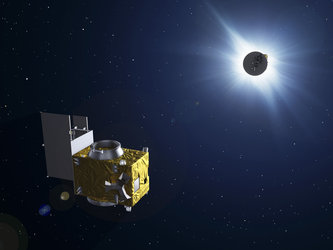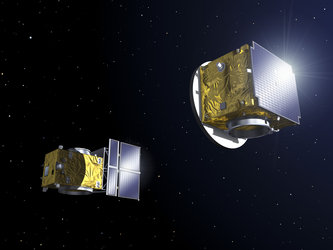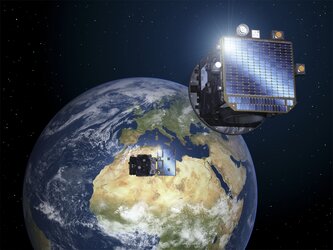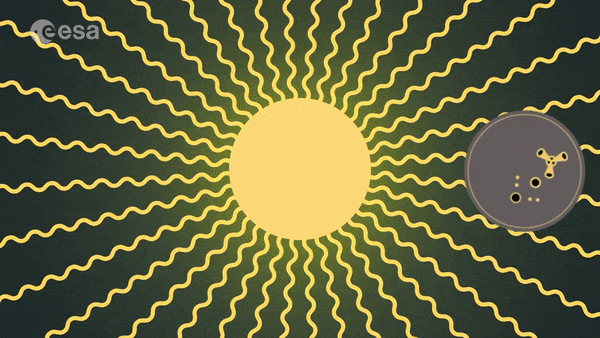Proba-3 Frequently Asked Questions
1. What are the Proba series of missions?
The Proba missions are a series of IOD (in-orbit demonstration) missions from the European Space Agency, for the demonstration and validation of new technologies and concepts in orbit. They are based on small satellites, embarking payload and instruments to deliver actual data to users to demonstrate a new capability. They are developed under ESA’s General Support Technology Programme (GSTP).
- Proba-1, launched in 2001, is an Earth observation satellite with advanced on-board autonomy and carries an innovative hyperspectral instrument. It has been operational for more than 20 years.
- Proba-2, launched in 2009, is observing the Sun, and carries 17 technology payloads and 4 scientific instruments.
- Proba-V (for Vegetation), launched in 2012, flies an innovative Earth imager, for multi-spectral global vegetation mapping.
- Proba-3, launched in 2024, demonstrates precise formation flying by flying two satellites to observe the Sun’s inner corona.
2. Who developed Proba-3 and how long did it take?
Proba-3 is a project more than ten years in the making, which has been implemented with the industrial support of more than 40 companies across Europe, under the leadership of a core team of companies in Spain and Belgium:
- Sener Aerospace (System Prime)
- Redwire Space (avionics, satellite assembly and testing, satellite operations)
- Airbus Defence and Space (satellite thermo-mechanics and propulsion, satellite environmental testing)
- GMV (formation flying algorithm and software, on-ground flight dynamics system)
- Spacebel (on-board, ground system and simulation software)
- Centre Spatial de Liège (Coronagraph scientific instrument)
3. Why are there two satellites?
Proba-3 consists of two satellites to create the conditions for observation of the Sun's corona. Together, the pair function as an extremely large instrument. One satellite features a telescope, kept in the centre of the shadow cast by the other satellite around 150 m away. Maintaining the correct position in the shadow requires a precise formation flying capability, down to a single millimetre of precision.
4. How is Proba-3 powered?
Each Proba-3 satellite is powered through high efficiency solar panels.
5. Do the satellites fly in formation autonomously or are they controlled from the ground?
As the Proba acronym indicates - ‘PRoject for OnBoard Autonomy’ - Proba-3's formation flying is controlled autonomously by the satellite pair.
6. Why do we need millimetre precision for the formation flying?
When in position, the two satellites will be precisely aligned so that the Occulter spacecraft casts a shadow onto the Coronagraph spacecraft. If the two are not perfectly aligned, then the bright disc of the Sun will not be hidden from the instrument and the Sun's corona will be obscured by its bright light.
7. Why is the formation flying being performed at such high altitude?
Any force exerted more on one satellite than the other will cause them to drift apart. This must be corrected for by the formation flying system, which consumes onboard propellant. Earth's gravity is one such force, along with vestigial atmospheric drag and Earth's magnetic field. Accordingly, Proba-3 performs its formation flying around the top of its more than 60 000 km altitude orbit, as far from these perturbing forces as possible.
8. Why do we need a 150 m distance between the Occulter and Coronagraph spacecraft?
Stray light can spill over the edge of coronagraphs, in a process called diffraction, which makes it difficult to observe the inner edges of the Sun's corona. Diffraction is exacerbated by a low distance between an occulter and a coronagraph. For Proba-3 the observing distance is around two orders of magnitude larger than that of any other coronagraph so far.
9. Why do we study the Sun's corona?
The Sun's atmosphere, called the solar corona, has many mysteries associated with it, starting with the counterintuitive fact that it is more than a million degrees hotter than the surface of the Sun underneath it. It is a major focus of scientific research and study – not only to improve our understanding of the Sun, but also as the origin of space weather, such as coronal mass ejections or solar storms, which can affect the functioning of satellites or communication and power networks down on Earth.
10. Why is it so hard to study the Sun’s inner corona?
The inner corona is the corona region that is close to the Sun. The Sun is around a million times brighter than the brightest point within the corona. If the light from the Sun is not blocked, any observing telescope is blinded by this light and cannot see the corona, like trying to see a firefly right next to a floodlight.
A coronagraph instrument, invented in the 1930s, uses one or more occulting discs to block the Sun’s light. However, when attempting to observe the inner corona, an optical phenomenon called diffraction causes light waves to spill around the edges of the occulting disc, reducing its effectiveness. To reduce the impact of diffraction, most coronagraphs use an occulting disc that is larger than the disc of the Sun. Unfortunately, this blocks the Sun's inner corona. A second method, used by Proba-3, is to place the occulting disc much farther from the coronagraph.
During a total solar eclipse, the Moon is the occulting body. Thanks to the Moon being the perfect size and very far from Earth, solar eclipses offer excellent opportunities to observe the inner corona. However, natural total eclipses are rare and very brief, lasting at most a few minutes. Proba-3 creates artificial total solar eclipses for six hours at a time in every 19hr 36min orbit.
11. How do Proba-3’s two satellites create an eclipse?
The satellite called the Occulter Spacecraft (or OSC) features an occulting disc of 1.4 m in diameter, which is kept perpendicular to the direction of the Sun’s light. This disc casts an 8 cm wide shadow from a distance of around 150 m onto the Coronagraph Spacecraft (or CSC). This satellite hosts a scientific telescope with a 5 cm aperture. Thanks to formation flying, the coronagraph aperture is maintained within the 8 cm shadow with millimetric accuracy, enabling corona observations. This happens when the two satellites are the furthest from Earth, at more than 60 000 km altitude – here, Earth's force of gravity is weaker, and formation maintenance requires less propellant.
12. When will we get the first results from Proba-3?
The first images of the Sun’s corona will be released on 16 June 2025.
13. How do the satellites autonomously perform active formation flying?
To begin with, star trackers – computer-linked cameras that recognise the constellations around them – chart each spacecraft’s ‘attitude’, or current pointing direction in space. For the lower part of their orbit, GPS receivers aboard both spacecraft compute relative positions to a high level of accuracy. The Proba-3 pair also continuously exchange ranging information and other data through radio inter-satellite links.
More is needed to achieve active formation flying, starting with Proba-3’s Vision Based Sensor system. A wide-angle camera is used to track an LED pattern on the other satellite, providing relatively coarse ‘first glimpse’ information on the satellites’ distance from each other, as well as supplementary information on their attitude. This is supplemented by a narrow-angle camera locking onto the same LED pattern, providing relative positioning information down to a scale of about a single centimetre.
Still finer positioning comes via the Fine Lateral and Longitudinal Sensor (FLLS) on Proba-3’s Occulter spacecraft. This instrument fires a laser beam, which is then reflected in the Coronagraph’s retroreflector back to the Occulter, where it is detected, enabling relative positioning down to a millimetre accuracy.
Finally, to ensure a steady lock, a Shadow Positioning Sensor system – based on photo detectors arranged around the Coronagraph telescope’s 5 cm diameter aperture lens – ensures that the Occulter’s approximately 8 cm diameter shadow remains cast correctly on all sides. Any discrepancy triggers a correction.
For manoeuvring, the mission employs a flight leader and wingman approach. The Coronagraph spacecraft is the leader, equipped with a propulsion system that it uses to break and acquire formation while also ensuring a safe formation during the rest of the orbit. The Occulter follows the Coronagraph’s lead by employing a cold gas thruster system, emitting puffs of nitrogen akin to tiny fractions of a single human breath. During the active formation flying phase the cold gas thrusters make small pulses every 10 seconds.
14. What has happened since launch?
The satellite pair was launched on a four-stage PSLV-XL rocket from Satish Dhawan Space Centre in Sriharikota, India, on 5 December 2024. The two spacecraft remained attached for the following six weeks until their planned separation on 14 January. Once separated, the satellites entered the next stage of the commissioning phase. This phase is still ongoing and includes the calibration and finetuning of both the onboard positioning system and the scientific instruments. In May, monitored by the ground control centre, the mission achieved autonomous precise formation flying for the first time, which enabled the spacecraft to create their first ‘artificial solar eclipse’. The images resulting from this milestone will be released on 16 June.
15. What other instruments are flying on Proba-3?
Besides the coronagraph instrument, Proba-3 carries the Digital Absolute Radiometer, DARA, supplied to the mission by the Physical Meteorological Observatory Davos in Switzerland. Mounted on the sunward side of the Occulter spacecraft, DARA will maintain a continuous measurement of the Sun’s total energy output, known as the total solar irradiance, which is an essential variable for climate studies.
Proba-3's third instrument, hosted on the other side of the Coronagraph spacecraft from its solar array, is the 3D Energetic Electron Spectrometer (3DEES). Supplied by Centre for Space Radiation at Belgium’s Catholic University of Louvain (UCLouvain), the Royal Belgian Institute for Space Aeronomy and aerospace manufacturer Redwire Space, 3DEES will measure electron fluxes as it passes through Earth’s radiation belts, providing useful data for space weather studies and astronaut health.
16. What is the planned mission lifetime?
The nominal lifetime of the Proba-3 mission is two years.
17. What will happen with the satellites at the end of the mission?
The mission is expected to last two years. Afterwards, gravitational perturbations from the Sun and the Moon will cause the satellites to naturally re-enter into the atmosphere within around five years after launch, in compliance with ESA's Zero Debris approach.
18. Which ESA Member States are supporting the mission, and how much does it cost?
The Proba 3 mission is being supported by 13 ESA Member States: Austria, Belgium, Czech Republic, Denmark, Ireland, Italy, Luxembourg, Poland, Portugal, Romania Spain, Switzerland and the United Kingdom together with Canada as Cooperating State.
The main contributors are Spain at 38%, Belgium at 34%, Poland and Romania at about 4% each, together with Austria, Luxembourg, Switzerland and the UK at about 3% each, against a total budget under ESA’s General Support Technology Programme (GSTP) of €200 million.
The 200ME mission cost comprises:
| Launch | ~30 M€ |
| Operations & ground stations | ~15M€ |
| Science payload development and operations | ~15M€ |
| Procurement of the two spacecraft & development of the formation-flying technologies | 140 M€ |
Spain and Belgium through their companies Sener, Redwire, Airbus Spain, Spacebel and GMV compose the core industrial team. Centre Spatial de Liège is responsible for the coronagraph instrument. Companies from the participating countries are contributing to all other aspects of the mission in space, such as formation flying technology, as well as to what happens on ground to ensure flight control, with mission operations and ground station infrastructure managed from ESA’s ESEC centre at Redu, Belgium.















 Germany
Germany
 Austria
Austria
 Belgium
Belgium
 Denmark
Denmark
 Spain
Spain
 Estonia
Estonia
 Finland
Finland
 France
France
 Greece
Greece
 Hungary
Hungary
 Ireland
Ireland
 Italy
Italy
 Luxembourg
Luxembourg
 Norway
Norway
 The Netherlands
The Netherlands
 Poland
Poland
 Portugal
Portugal
 Czechia
Czechia
 Romania
Romania
 United Kingdom
United Kingdom
 Slovenia
Slovenia
 Sweden
Sweden
 Switzerland
Switzerland




































